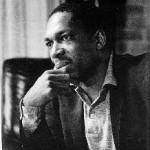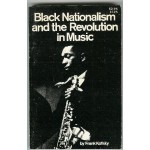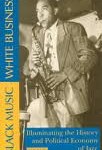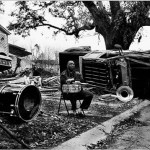Those who’ve been around jazz, African American classical music, American classical music, creative music, BAM or whatever your preferred nomenclature for the art of the improvisors that is based upon the African experience in America and European concepts and instruments, have to know that the radio airways, even what precious little we’ve been able to experience over the last thirty years or so is an endangered species.
First the wolves of commerciality and bland, formulaic radio cleansed the commercial airways of jazz music. New York-area listeners back in the day remember the day former all-jazz radio WRVR went country music overnight. Until a group of brave, hearty souls gave birth to WBGO, that meant the New York metropolitan area, arguably the mecca for this music, was suddenly without a full-time jazz outlet. Like the proverbial domino effect jazz music soon became extinct on the commercial airways, with the Bay Area’s KJAZ’ demise signaling the turn out the lights the party’s over end of the music on the commercial airways as we knew it.
Ah, but then we just knew we had a safe new home on the public and community FM airways on the far left end of the dial in perpetuity, right? Not so fast ma’am, seems no ground is safe from assorted wolves who would rule this music not even commercial enough to ignite significant numbers of listener-supporters (but then try selling that false platitude to WBGO or SoCal’s KJZZ!). Seems the wolves this time come cloaked not in the flimsy garments of commerciality, this time they’ve got a seemingly unquenchable thirst for more, more, more news/talk & information. Forget the fact that 21st century radio is deeply over-sexed with news/talk & information formats, not to mention the fact that even those stations which purport to be music at their core seem compelled to squeeze in as much talking head babble as possible, we have non-commercial radio airways over-wrought with non-stop chatter.
The latest creative music bastion to fall victim to the false notion that music listeners won’t support stations with their membership drive largesse is Boston’s WGBH (check The Independent Ear for a recent editorial and subsequent petition drive on this latest sorry chapter in the erosion of non-commercial music from the public & community airways). To see stalwart creative music broadcasters like Eric Jackson and Steve Schwartz either neutered, kicked to the curb or outright expelled has indeed been a sorry saga. Once again the replacement programming is slated to be more news/talk & information. And this is happening in a great city that boasts perhaps more creative music students per capita than any other American city, including home to the leading contemporary music conservatory in the world, Berklee College of Music.
Likely the next radio station to face a similar fate is WPFW, Pacifica Radio in Washington, DC, at 89.3 FM and streaming live at www.wpfw.org. Founded in 1977 by a stalwart group of largely African Americans (in the days back before gentrification, when DC was truly “Chocolate City”), WPFW’s mission statement has jazz music front and center as a core broadcast element. WPFW has forever been viewed within the Pacifica Radio network as something of a stepchild for two reasons: its African American constituency and majority African American management and programming staff. Another factor that has long been WPFW’s “difference” even in the supposedly progressive ranks of Pacifica Radio (the last bastion of left-wing radio on the American airways) is the in-house Pacifica viewpoint that WPFW is “…that music station…” I’ve been a programmer at WPFW since 1989; first as the long time host of the Friday afternoon Drivetime Jazz slot (for years 4-7pm then cut to 4-6pm by management’s stated need for more news/talk & information), more recently as host of the Thursday Morning Drivetime Jazz slot 5-8am. In addition to jazz WPFW has also long been the DC area’s radio home for blues, old school R&B, Latin music, African music, and assorted Caribbean island music – certainly befitting a metropolitan area that boasts not only a large African American populace, but is also a world city with the largest Ethiopian populace outside of that nation, as well as robust African and Caribbean communities.

For many years the jazz/creative music sector of WPFW’s broadcast day has included M-F 5-8am, 1-3pm, 4-6pm, 8-10pm, and for the most part 11pm-5am. Though there is no jazz programming on Saturdays, when blues, old school R&B, Caribbean, and Haitian music rule, WPFW’s Sunday jazz programming sequence is robust and quite popular with listeners, running from 6am-6pm. Clearly this is one of the most robust jazz/creative music menus in the country. That too is threatened by what I have referred to as the NPR-ization of WPFW, rolling down the pike at a precipitous pace many of us fear. The first inkling of this runaway freight train came several months ago when an associate of station General Manager John Hughes’ gave a presentation at a station retreat that strongly suggested that jazz in the morning is not what listeners want to hear, they want to hear news/talk & information in the morning!
Since then WPFW has become burdened by a lack of creative fundraising that has resulted in a gross over-reliance on what has become a frayed old hat in the public and community radio world: the dreaded on-air listener plea known as the Pledge Drive. Frankly that method of fundraising has become hackneyed in the least; at worst over-reliance on on-air fundraising taxes its listeners and leads inevitably to listener fatigue. Take the pulse of the WPFW listening audience in Washington and a familiar refrain will go something like this: “…I get tired of ya’ll always pitching for pledges…” Where once WPFW listeners endured three seasonal pledge drives (Fall, Winter and Spring – where notably some public and community radio stations only endure two such drives annually) of two sometimes three weeks in duration, now listeners are tagged with intermittent “mini-drives” designed to make up for fundraising shortfalls that have inevitably increased the epidemic of WPFW listener/donor fatigue and subsequent tune-out.
Current WPFW management posture has been to give nice lip service about seeking fundraising alternatives, while the reality includes increased pledge drives as the bandaid towards station financial solvency. (It should be noted here that one of the fundamental precepts of Pacifica Radio is that its stations do not accept underwriting support from any corporations or businesses whatsoever. This is a precept designed to protect Pacifica stations from undue corporate or business influence and meddling. However its my contention that precept has become outmoded, particularly when one considers the fact that there are numerous progressive, socially-responsible entities in the community that would step up to the plate with underwriting support; witness the underwriting support that is the lifeblood of WWOZ in New Orleans and is all local business driven; Exxon, Shell, William & Morris, Haliburton, etc. need not apply.)
Now comes the wisdom lurking in the shadows that the jazz and creative music listening audience simply does not support the station in significant enough numbers to sustain WPFW (which currently touts itself as “Your station for Jazz & Justice”; and for its 30th anniversary gala honored Sonny Rollins and Amy Goodman, pillars of Jazz & Justice). The hungry wolves of more news/talk & information are baying at the door of WPFW and it is suspected that the programming changes hinted in a recent, veiled, typically passive-aggressive email to station programmers from GM John Hughes (with words to the effect that he’s going to bring in new, syndicated programming that will raise greater revenue for the station) will include a significant loss of jazz and creative music programming hours. As we say in radio… stay tuned. And if it is your pleasure to take the preemptive step of lodging a protest on the coming programming changes (September is the due date for these programming shifts) you can do so in several ways: communicate with station management via the website www.wpfw.org; by snail mail at WPFW, 2390 Champlain Street NW, Washington, DC 20009; by fax to 202/588-0561; by calling station GM John Hughes at 202/588-0999 and press 0 for the operator; or by calling in to his weekly General Manager’s Mailbag show on Friday mornings 9-9:30am at 202/588-0893.
Which brings me to another salient point: as jazz radio listener-supporters we are so often late to the party. Dr. Billy Taylor used to decry what a lax lot we are, how we are always too late to protest draconian changes and elimination of jazz formats. We moan & cry loud and long AFTER the axe has fallen – witness the anger and collective teeth gnashing of the Boston area jazz community AFTER WGBH emasculated its jazz programming hours. By then the genie is way out of the bottle and it is far too late; those programming changes have been set in stone. If you hear or see the warning signals on the horizon at your local jazz and creative music outlet, take preemptive protest strikes THEN, before those egregious changes have been instituted.
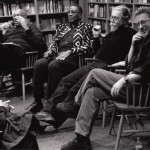
Four of WPFW’s veteran jazz programming crew: L to R – Willard Jenkins, Askia Muhammad, Rusty Hassan, Larry Appelbaum




